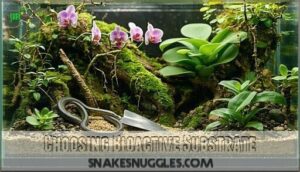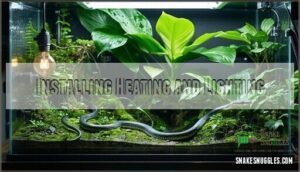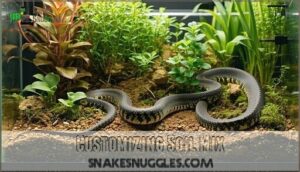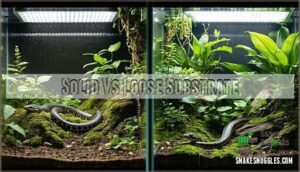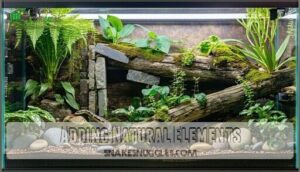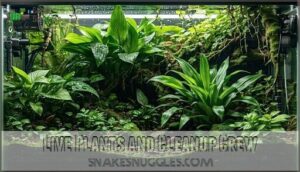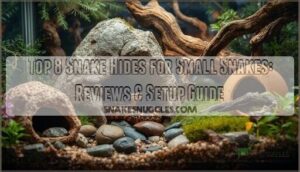This site is supported by our readers. We may earn a commission, at no cost to you, if you purchase through links.
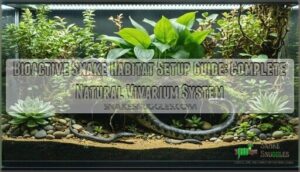
Introduce cleanup crews like springtails and isopods—they’re your waste management team working 24/7. Choose hardy plants like pothos or snake plants that handle your terrarium’s specific humidity levels.
Install proper heating and UVB lighting to keep everything balanced. The magic happens when beneficial bacteria, decomposers, and plants work together to break down waste naturally.
Your snake gets enrichment through burrowing and exploring while you get a beautiful, low-maintenance habitat that practically runs itself once established.
Table Of Contents
- Key Takeaways
- Snake Species Selection
- Terrarium Setup Essentials
- Substrate and Ecosystem
- Live Plants and Cleanup Crew
- Bioactive Habitat Maintenance
- Frequently Asked Questions (FAQs)
- How do you choose a bioactive enclosure for a snake?
- What is a bioactive snake terrarium?
- How do I set up a bioactive snake terrarium?
- Why do snakes need a bioactive enclosure?
- What is a bioactive setup?
- How do you choose a bioactive substrate for a snake?
- Are bioactive enclosures good for snakes?
- What is the best substrate for bioactive ball pythons?
- How often should bioactive substrates be replaced?
- Can venomous species live in bioactive setups?
- Conclusion
Key Takeaways
- You’ll create a self-sustaining ecosystem using a drainage layer, bioactive substrate mix (40% organic soil, 30% sand, 20% orchid bark), and cleanup crews like springtails and isopods that handle waste breakdown 24/7.
- You’ll choose beginner-friendly species like ball pythons or corn snakes, then research their natural habitat conditions to replicate proper temperature gradients, humidity levels, and environmental features in your setup.
- You’ll select hardy, snake-safe plants like pothos and snake plants that can handle trampling while providing natural enrichment, combined with strategic placement of hides, branches, and basking spots.
- You’ll maintain your bioactive system by monitoring temperature gradients (88-92°F basking spots), controlling humidity levels (50-60% for ball pythons, 40-50% for corn snakes), and checking substrate moisture without frequent deep cleaning since the ecosystem maintains itself.
Snake Species Selection
Choosing the right snake species sets the foundation for your bioactive habitat’s success.
Ball pythons and corn snakes are excellent beginner choices because they’re hardy, have manageable care requirements, and adapt well to naturalistic setups that mimic their wild homes.
Ball Pythons and Corn Snakes
When you’re starting your bioactive journey, ball pythons and corn snakes are perfect beginner snake species.
These captive breeding champions offer stunning morph variations while thriving in bioactive terrariums. Ball pythons’ docile nature makes handling techniques straightforward, while corn snakes adapt beautifully to enclosure enrichment.
Both species flourish with bioactive substrate and cleanup crews, creating self-sustaining ecosystems that’ll make maintenance a breeze.
Researching Natural Habitat
Understanding your snake’s regional roots reveals the secret to creating their perfect home.
Research your species’ geographic region, vegetation types, humidity levels, temperature ranges, and substrate types from their wild environment.
Ball pythons need African savanna conditions, while corn snakes require southeastern U.S. forest setups.
Study seasonal patterns in their naturalistic habitat to replicate authentic microclimate conditions that promote natural behaviors.
Proper ventilation is also key, as optimal airflow is essential for a healthy enclosure.
Considering Size and Temperament
Your snake’s adult size dictates enclosure requirements—ball pythons need 4x2x2 feet minimum, while corn snakes thrive in 3×1.5×1.5 feet.
Right-sized homes keep your slithery friends happy and healthy.
Temperament matters too: docile beginner snakes like these species tolerate handling frequency better than defensive ones.
Match your experience level with suitable snake species that display calm natural behaviors and adapt well to captivity.
Terrarium Setup Essentials
Building your bioactive terrarium starts with four critical layers that work together like a natural ecosystem.
You’ll create a drainage foundation, select living substrate, add plants and decorations, then install proper heating and lighting to support both your snake and the microscopic life that keeps everything balanced.
Creating Drainage Layer
Before you worry about soggy soil ruining your snake’s home, a proper drainage layer acts like your terrarium’s foundation.
Use hydroton clay balls or gravel as your base material, then add landscape fabric or window screen for layer separation.
This waterlogging prevention system stores excess water while keeping roots healthy, preventing root rot that kills plants fast.
They’re often used for hydroponic growing media, which can be a key component in a successful hydroponic setup.
Choosing Bioactive Substrate
Now you’ll pick your soil mix – think of it as your snake’s foundation for life.
The right substrate composition makes or breaks your bioactive snake terrarium success.
Your snake bioactive substrate needs the perfect recipe for moisture retention and microfauna support:
- Base blend: 40% organic topsoil, 30% play sand, 20% orchid bark for proper drainage
- Burrowing depth: 4-6 inches minimum to accommodate natural digging behaviors
- Species specificity: Add sphagnum moss for humid-loving ball pythons, extra sand for arid species
This substrate mix creates the sweet spot between holding water and letting excess drain away.
Consider purchasing pre-mixed substrate blends for convenience.
Adding Live Plants and Decorations
After preparing your substrate, it’s time to bring your terrarium to life with strategic Plant Placement and thoughtful Aesthetic Design.
Choose nontoxic plants like pothos and snake plants that tolerate trampling while avoiding Plant Toxicity concerns.
Position sturdy decorations near heat sources for ideal growth, creating natural decor that enhances Enclosure Enrichment without compromising Decoration Safety for your snake’s well-being.
Installing Heating and Lighting
Setting up your terrarium lighting feels like orchestrating a sunrise every day.
Install your basking bulb choice on one side to create a proper temperature gradient of 70-85°F.
Add UVB lighting for 10-12 hours daily, mimicking natural cycles.
Use ceramic heating devices as your nighttime heat source to maintain thermal gradients.
Thermostats guarantee consistent temperatures and prevent overheating.
Always implement lighting safety measures with proper fixtures and timers for consistent terrarium lighting, ensuring a proper temperature gradient.
Substrate and Ecosystem
Your substrate creates the living heart of your bioactive terrarium, where beneficial microorganisms break down waste and support plant growth.
Think of it as building a miniature forest floor that’ll keep your snake’s home clean and thriving for years, with a bioactive terrarium.
Customizing Soil Mix
Your soil mix recipe determines your terrarium’s success.
The right soil mix makes or breaks your bioactive snake terrarium success.
Blend 40% organic soil, 30% play sand, and 20% orchid bark for balanced texture variation and moisture control.
Add 10% activated charcoal for pH levels and odor management.
Tropical species need extra sphagnum moss, while arid snakes require more sand.
For ideal burrowing, consider a 3-inch substrate layer.
This nutrient balance supports both plants and cleanup crews perfectly.
Solid Vs Loose Substrate
Loose substrate beats solid options hands down for creating thriving bioactive environments.
Your snake’s natural instincts kick in with soil mixes that support digging and exploration. Optimal substrate depth allows for tunneling and exploration.
- Moisture Retention: Loose substrate holds humidity better than solid materials, creating stable microclimates
- Burrowing Behavior: Soft soil textures allow natural digging patterns that reduce stress and encourage activity
- Plant Support: Proper substrate depth gives roots room to grow while supporting beneficial microfauna habitat
Building Foundation Layer
Beyond the drainage layer, you’ll build your bioactive snake habitat’s foundation using specific layer components.
This substrate depth creates the perfect base for your snake enclosure setup.
| Layer Component | Depth | Purpose |
|---|---|---|
| Soil & Sand Blend | 3 inches | Drainage materials support |
| Coconut Fiber | 1 inch | Microfauna support base |
| Clay Particles | 0.5 inches | Heat gradients regulation |
Start with organic topsoil mixed with sand for your substrate layer.
This bioactive vivarium foundation supports beneficial bacteria while maintaining proper drainage for your snake’s health.
Adding Natural Elements
Once your substrate foundation settles, you’ll want to scatter oak leaf litter across the surface like nature’s own carpet.
This natural decor feeds your cleanup crew while creating perfect hiding spots.
Add cork bark pieces and climbing branches at angles your snake can navigate easily.
Stone features near the basking area provide thermal mass, while strategically placed rock placement creates natural hides that’ll make your slithery friend feel right at home, utilizing thermal mass and natural hides.
Live Plants and Cleanup Crew
Now you’ll transform your carefully prepared substrate into a living ecosystem that works around the clock.
This stage brings together hardy plants that can handle snake traffic and tiny cleanup crews that keep everything fresh and balanced, including the concept of tiny cleanup crews.
Selecting Hardy Plants
Your plant selection determines your vivarium’s success rate.
Choose hardy, snake-safe species like pothos and sansevieria that handle trampling while maintaining low plant toxicity levels.
These vivarium plants tolerate poor light requirements and varying humidity tolerance, making plant placement flexible.
Consider each species’ growth rate and root structure when designing your live plants layout for ideal safe plants performance.
Introducing Springtails and Isopods
Your bioactive cleanup crew forms the backbone of waste management.
Start with springtails first—they’ll tackle mold and create stable Springtail Colonies within 48-72 hours. Then add dwarf white isopods for solid waste breakdown.
This Species Diversity maximizes Isopod Benefits while preventing competition. Springtails for bioactive are essential for a thriving vivarium.
Monitor your bioactive cleanup crew every two weeks for Population Control, ensuring they don’t overwhelm the substrate. Provide Microfauna Food through leaf litter to sustain healthy populations.
Creating Habitat Structure
Sturdy branches and cork logs create essential climbing surfaces while flat rocks provide perfect basking spots.
Position hides strategically under these structures to maximize your enclosure size efficiently.
Natural habitat enrichment comes from layering these elements at different heights, creating a naturalistic terrarium setup that should mimic wild terrain.
Your snake should have multiple pathway options for exploring their new home, giving them a sense of freedom to roam and discover.
Balancing Aesthetics and Functionality
Your terrarium design shouldn’t look like a sterile lab experiment.
Think of it as creating a living painting where every cork branch and pothos vine serves double duty.
Visual appeal draws you in, but practical design keeps your snake healthy.
Smart placement of natural decor creates snake enrichment opportunities while maintaining habitat harmony.
Your bioactive system becomes a stunning naturalistic terrarium that actually works.
Bioactive Habitat Maintenance
Once you’ve established your bioactive snake habitat, you’ll need to maintain specific environmental conditions to keep everything thriving.
Regular monitoring of temperature, humidity, and substrate moisture guarantees your snake stays healthy while your cleanup crew continues working efficiently, which is crucial for maintaining a bioactive environment.
Maintaining Temperature Gradient
Your snake’s thermal gradients create the perfect recipe for healthy behavior and digestion. Think of temperature zones like different rooms in a house – each serves a specific purpose for your scaly friend.
- Basking Spot Temp: Keep it between 88-92°F for ball pythons, 85-88°F for corn snakes
- Heat Source Placement: Position ceramic heat emitters or under-tank heaters on one end only
- Nighttime Temperature Drop: Allow temps to drop 5-8°F to mimic natural cycles
- Thermostat Calibration: Use digital thermostats with probe sensors for accurate control
- Monitoring Methods: Check temperatures with infrared thermometers and multiple digital gauges
Controlling Humidity Levels
Maintaining proper humidity becomes your bioactive system’s lifeline, requiring careful balance between misting frequency and ventilation needs.
Digital hygrometers provide accurate monitoring tools for tracking humidity levels across different zones. Ball pythons need 50-60% humidity, while corn snakes prefer 40-50%.
Control humidity management through strategic misting, water bowl placement, and substrate moisture adjustments. Ideal humidity ranges are essential for snake health.
Create humidity gradients using partial mesh covers and targeted ventilation for ideal humidity control throughout your vivarium.
Monitoring Substrate Moisture
Checking your substrate’s moisture levels keeps your bioactive system healthy and prevents problems before they start. You can’t just set it and forget it—regular monitoring helps you spot issues early.
Here’s how to track moisture like a pro:
- Moisture Meters – Digital probes give instant readings at different substrate depths
- Visual Inspection – Look for dry patches, overly wet spots, or mold growth weekly
- Hydrometer Placement – Position gauges at substrate level, not just air space
- Substrate Depth checks – Test moisture 2-3 inches down where roots live
Seasonal variation affects your setup too. Winter heating dries things out faster, while summer humidity builds up.
Sphagnum moss works as your moisture buffer, soaking up excess water when it’s too wet and releasing it when things get dry. Adjust your misting frequency based on what your meters tell you, not just a rigid schedule.
Ensuring Proper Drainage
Without proper drainage, your bioactive setup becomes a swampy mess that kills plants and creates unhealthy conditions.
Use hydroballs or clay as drainage materials beneath landscape fabric for effective layer separation.
This prevents waterlogging and root rot while maintaining moisture control.
Consider bulkhead systems for easy water removal, ensuring your well-draining substrate stays perfectly balanced.
Frequently Asked Questions (FAQs)
How do you choose a bioactive enclosure for a snake?
You’ll want to match your enclosure size to your snake’s adult length and habits.
Consider if they’re terrestrial, arboreal, or semi-arboreal, then choose glass or PVC construction with proper ventilation and secure locking mechanisms.
This ensures that the snake has an appropriate environment that matches its natural habits.
What is a bioactive snake terrarium?
Nature abhors a vacuum, so bioactive terrariums create complete ecosystems.
You’re building a living habitat where beneficial microorganisms, springtails, and isopods break down waste naturally, while live plants maintain humidity and air quality for your snake.
How do I set up a bioactive snake terrarium?
Start with a drainage layer, add 4-inch bioactive substrate mix.
Install heating and UVB lighting.
Introduce hardy plants like pothos, add cleanup crew of springtails and isopods.
Then include hiding spots.
Why do snakes need a bioactive enclosure?
Snakes don’t actually need bioactive enclosures to survive, but they thrive in them.
These living ecosystems reduce stress, encourage natural behaviors like burrowing and climbing, and create self-cleaning environments that benefit your snake’s health.
What is a bioactive setup?
A bioactive setup mimics nature’s ecosystem in your snake’s enclosure.
It’s a living system where plants, beneficial bacteria, and cleanup crew insects like springtails work together to break down waste naturally, creating a self-maintaining habitat.
How do you choose a bioactive substrate for a snake?
The right substrate mix creates the foundation your snake needs to thrive. You’ll want 40% organic topsoil, 30% play sand, 20% orchid bark, and 10% activated charcoal for ideal drainage and nutrition.
Are bioactive enclosures good for snakes?
Yes, bioactive enclosures are excellent for snakes.
They reduce cleaning work, encourage natural behaviors like burrowing and foraging, and create self-sustaining ecosystems.
The cleanup crew handles waste while live plants regulate humidity naturally, which is a key aspect of maintaining a healthy environment with bioactive enclosures.
What is the best substrate for bioactive ball pythons?
When the going gets tough, the tough use proper substrate! You’ll want a mix of 40% organic topsoil, 30% play sand, 20% orchid bark, and 10% activated charcoal for your ball python’s bioactive home.
How often should bioactive substrates be replaced?
You don’t need to replace bioactive substrates regularly – they’re designed to last years with proper maintenance. Simply spot-clean waste and refresh the top layer occasionally.
Can venomous species live in bioactive setups?
Playing with fire takes on new meaning when venomous snakes meet bioactive setups.
While technically possible, it’s extremely dangerous and typically illegal without proper permits.
The cleanup crew can’t handle venom, and maintenance becomes life-threatening.
Conclusion
Successfully establishing a bioactive snake habitat setup guide transforms 90% of traditional terrariums into self-sustaining ecosystems within just 6-8 weeks.
You’ve created something amazing – a living system where plants, cleanup crews, and beneficial bacteria work together around the clock.
Your snake gets natural enrichment while you enjoy dramatically reduced maintenance.
The initial setup takes effort, but you’ll soon watch your bioactive snake habitat setup guide pay off as everything balances perfectly, giving you more time to simply enjoy your thriving reptile companion.
- https://reptifiles.com/corn-snake-care-guide/corn-snake-substrate/
- https://terrariumtribe.com/bioactive-substrate/
- https://www.reddit.com/r/ballpython/comments/mkp12o/megathread_substrate/
- https://www.joyusgarden.com/repotting-snake-plants/
- https://www.thebiodude.com/blogs/how-to-setup-a-bioactive-vivarium-terrarium-or-paludarium/long-term-maintenance-of-bioactive-habitats-what-you-need-to-know


